Port of Liverpool, England
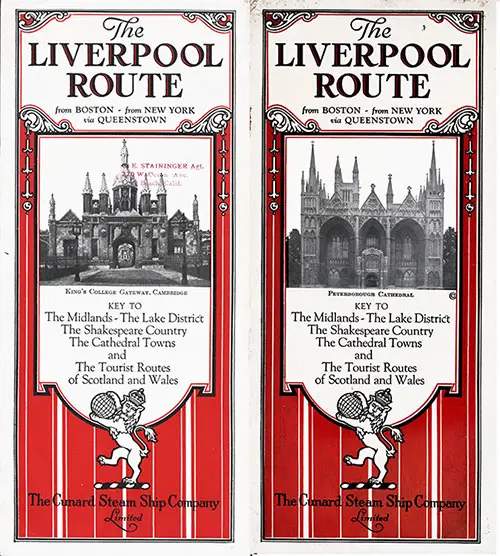
Cover of a 1923 Brochure "The Liverpool Route," from the Cunard Steamship Company, Ltd. GGA Image ID # 1198639f30
Liverpool England was an important port for Steamships in both numbers of passengers, including immigrants to American who went through this port on their way to the new World.
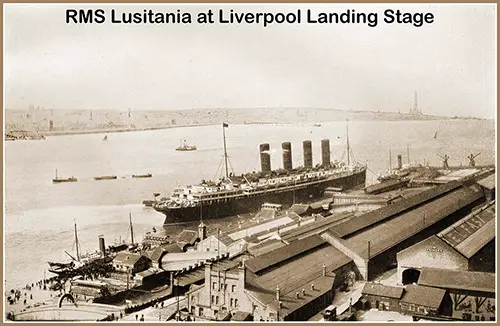
RMS Lusitania at the Liverpool Landing Stage (1912). Cunard Daily Bulletin, Summer 1912. GGA Image ID # 2110cb07c4
During the latter half of the 19th century Liverpool became Britain's No 1 port for passengers wishing to travel to America, and earned for itself the soubriquet The Gateway to the West.
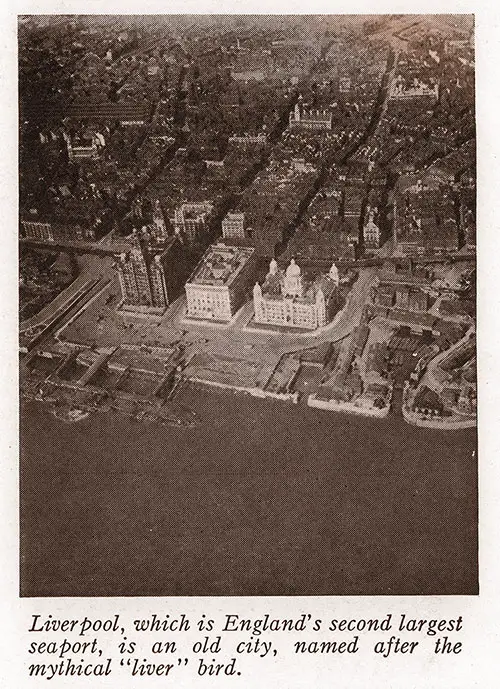
Liverpool, England's Second Largest Seaport, Is Named after the Mythical "Liver" Bird. Going Abroad, 1923. GGA Image ID # 1bcff09906
Liverpool Landing Stage Improvements (1922)
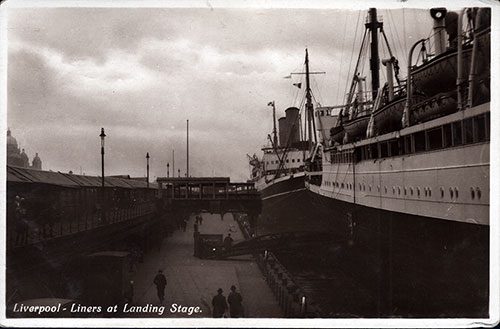
Liners at the Landing Stage at Liverpool. nd ca early 1900s. GGA Image ID # 211209ca39
The following is a general description of the intended work of the Mersey Docks and Harbor Board at the Prince’s Landing stage, Liverpool, to improve the facilities for dealing with overseas passengers.
The removal of the existing curved roof over the southern end of the Stage buildings, about 500 feet in length, and the substitution therefor of a flat deck in continuation southwardly of the existing Hat deck. This, when completed, will provide a continuous upper deck having a total length, including the existing deck, of about 1,100 feet.
Access will be provided from the lower to upper decks by means of staircases placed at suitable Intervals apart. To enable passengers to pass to and from the upper deck to vessels berthed alongside the Stage four movable overhead gangways will be available.
For the protection and comfort of passengers passing to or from vessels and the baggage examining rooms or the Pier Head and Riverside Station in wet or stormy weather a covered gangway 12 feet wide will be constructed on and for the fall length of the upper deck on Its eastern side.
Under the upper deck more commodious and better waiting-room accommodations will be provided; also medical officers' rooms for the examination of passengers. The structural alterations referred to above also entail a rearrangement of the Customs Offices, refreshment rooms, etc.
The Stage end of No. 4 bridge will be raised to and maintained at the level of the upper deck, and thus provide direct access to and from the extended upper deck and the Prince's Parade. Similar access to the existing upper deck is already provided by No. 6a bridge.
Additional baggage examining accommodation will be provided in a room 217 feet long by 83 feet wide overall, to be constructed between Nos. 5 and 6 bridges. The floor will be at the level of the Prince's Parade, and ease of access from the Riverside Station. Two conveyors, electrically driven, will be provided for transferring baggage from the lower deck of the Stage to the examining room. The internal arrangements will be made as up-to-date as possible, and will include a post office and telephone boxes, lavatories, Customs searchers’ rooms, inquiry office, etc., etc.
The examining room and the upper deck of the Stage will be connected by means of a footbridge, 10 feet wide, for the use of passengers and other persons. This building, when completed, will add 100 percent to the present accommodation. The new baggage-examining shed is so designed that an additional floor can. If required, be added at some future time.
Arrangements at Liverpool Landing Stage and Routes to London (1913)
Arrangements at Liverpool.
ROUTES TO LONDON.
There are several Great Western Railway routes between the Port of Liverpool and London, and travellers have the choice of the following, being also permitted to break the journey at any station en route, provided the journey be completed within the period shown.
- The DIRECT ROUTE passing through Chester, Shrewsbury, Birmingham, Leamington, Bicester, etc., etc.
- The " ROYAL" SHAKESPEARE Route skirting the border of Wales and passing through Chester, Shrewsbury, Birmingham, Stratford-on-Avon, Warwick, Leamington, Oxford, Reading, Slough and Windsor.
- The SEVERN VALLEY or Wolverhampton, Kidderminster and Worcester Route passing through Chester, Shrewsbury, Bridgnorth, or Wolverhampton, Kidderminster, Worcester, Stratford-on-Avon, Oxford, Slough and Windsor.
- The HEREFORD, ROSS AND GLOUCESTER Route passing through Chester, Shrewsbury, Ludlow, Hereford, Ross, Monmouth, Tintern, Chepstow, Gloucester, Slough and Windsor.
- The HEREFORD, BRISTOL AND BATH Route, at slightly increased fares, passing through Chester, Shrewsbury, Ludlow, Hereford, Abergavenny, Bristol, Bath, Slough and Windsor.
All these routes embrace Wrexham, the burial place of Elihu Yale, founder of Yale University.
If it be desired to reach the Continent direct from Liverpool without making any stay in England, travellers are able to join through carriages at Birkenhead (Liverpool) for Folkestone or Dover via Reading.
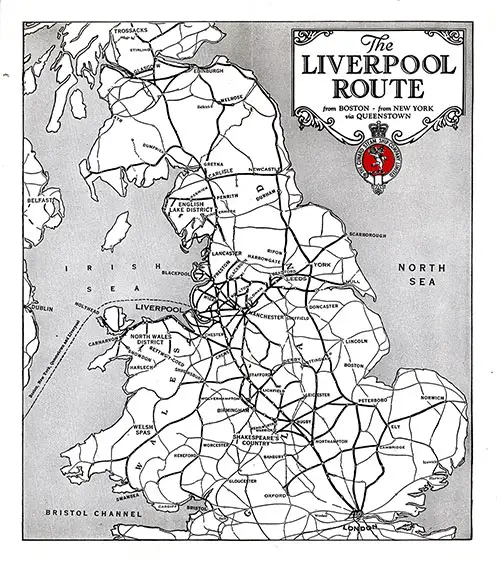
Map of the Liverpool Route: Boston-New York via Queenstown (Cobh), 1923. Sketch Map Shewing Routes to London. Through Express Services Without Change of Carriage. G.W.R. Bristol to Birmingham, Cheltenham, Leicester, Sheffield, Manchester, Leeds, Bradford, Liverpool, Newcastle, Glasgow, Edinburgh, and Other Important Cities in the North. Ask For Tickets by Great Western. GGA Image ID # 1d59a0841d
G.W.R. REPRESENTATIVES
The Great Western Railway Company's representative meets the steamers, on their arrival at Liverpool, to render assistance to Passengers by the Great Western Routes.
Through tickets can be obtained at the Great Western Company's Office in the Custom House Waiting Room.
BAGGAGE
Passengers taking or holding through tickets to London incur no expense at Liverpool, as, after passing their baggage through the Custom House, Dock porters transfer it at no cost to the owners.
Heavy luggage can, if so desired, be checked through to London direct or any station on the Great Western Railway, and no charge for conveyance by rail is made if within the weight allowed free.
The Company will also arrange, upon payment of 6d. (13 cents) per package, for the luggage to be delivered at any hotel or residence within a certain radius at the principal places served by the Great Western Railway.
RESERVATION OF SEATS OR CARRIAGES.
The Company's Agent at 11, James Street, Liverpool, will, on receipt of a telegram from Queenstown, arrange for ,the retention of compartments in through carriages. Compartments are retained for four first class or six third class Passengers, or on payment of the fares for these numbers.
ACCOMMODATION IN LONDON.
Upon notification, the Great Western Officials who meet the liners at Liverpool will telegraph free of charge for accommodation to be reserved at the Royal Hotel, Paddington, or will order private omnibuses in the same way, if required.
AVAILABILITY OF TICKETS.
Great Western Railway Single Tickets and outward halves of Return Tickets between Liverpool and London are available for three months if purchased in America, or if issued in exchange for Vouchers obtained in America. In other circumstances they are available for ten days.
Passengers are permitted to break the journey at any station on the route, provided the journey be completed within the periods named above. Return Tickets are available for six months. The same privileges are allowed to passengers journeying from London to Liverpool.
G.W.R. TIME TABLES.
Great Western Time Tables are on board all Liners for reference.
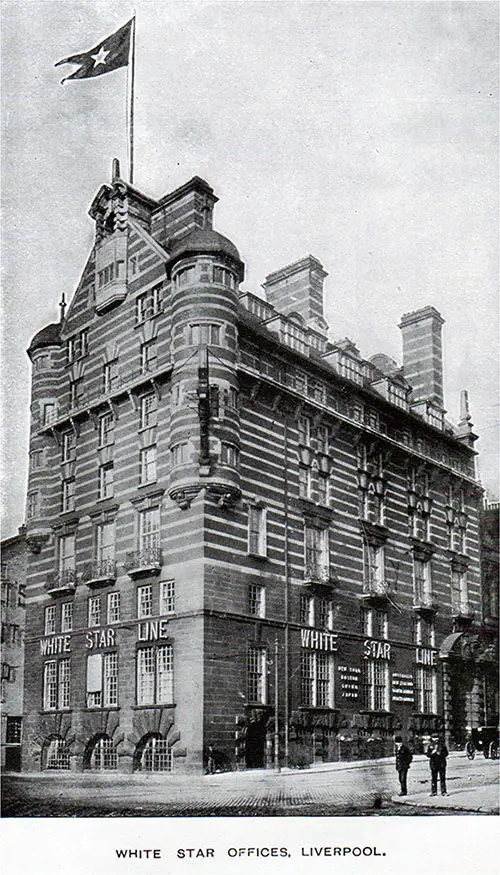
White Star Line Offices, Liverpool. White Star Line Services, 1907. GGA Image ID # 145090e6c6
TRAVELERS RETURNING
FROM ENGLAND Via LIVERPOOL.
The Superintendent of the Line, Paddington Station, London, will furnish all particulars to Passengers who wish to avail themselves of the advantages afforded by either of the Great Western routes between London and Liverpool.
On receipt of notification and the purchase of tickets covering the journey, the Great Western Company will collect, within a certain radius, Passengers' luggage in London and principal towns served, and see that it is placed on the outgoing vessel, at a charge of 18. (25 cents) per package.
Luggage brought to any Great Western Railway Station by Passengers will be sent direct to Liverpool and placed on the outgoing vessel at a charge of 6d. (13 cents) per package, in each case up to the weight allowed according to the class of ticket held, which must be produced at the time.
HAND BAGGAGE may be left at the Company's Office, 11, James Street, Liverpool, to be delivered to the outgoing vessel, no charge being made for the service.
Passengers travelling by the Great Western route to the Central Station of the Mersey Railway Company can have their baggage delivered from the Central Station to the vessel free of charge.
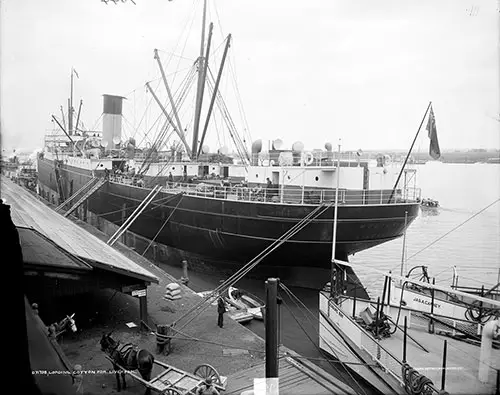
Loading Cotton Onto the SS Meltonia at the Liverpool Landing Stage, ca 1910. GGA Image ID # 21121d49bd
Making a Landing at Liverpool
IT was an experience, of course, for many aboard the boat. Liverpool has stood synonymous for England's marine greatness since the birth of the eighteenth century, and now that landing here was at hand, newcomers to the port, and even those come before, were eager for first sight of the dock.
Here on the Irish Sea, at hand, numbers of herring-boats dotted the water, each with its sails a dark maroon, and recalling, at once, the sardine-fleet of the East Adriatic. Off on our left, another liner was making for harbor, and we wondered whether aboard her, too, folk had dressed up for the landing as here.
The day was a splendid one, and the air of the clearest, so that already 10:34 by the watch, due ahead, out the sea there rose England's latest pleasure-ground, the far-famed New Brighton Tower. It seemed much like the Eiffel of France. On its left hand no land was met in sight, while on the right dim blue mountains lay; these hidden, now and then, from view by the smacks on the dark blue sea.
Dinner-time came early as interruption, and just as folk returned to the deck from this, the pilot was climbing aboard, from a curious, yellow skiff, in which four men, in yellow slickers and caps of red, manned an oar apiece. The bos'n of this crew had a blue sweater on; otherwise all dressed alike.
Off a bit;, the pilot-boat itself lay pitching, a curious structure of yellow and black, with a stubby fore and rear mast.
Gulls innumerable circled around as we stopped here, one of six huge smoking steamers, awaiting the pilot-boats picking them up. On our right a side-wheeler passed, on the Isle of Man crossing, it unique for the two smokestacks bent very far back. On ahead, a low yellow coast had put in appearance, on the right the Tower continued to grow.
Creeping onward, a lightship with two queer balls went, behind us other ships passed by and saluted. Far out in our prow meanwhile, a lone woman took her position, eager indeed for the first glimpse of the dock. She was coming home from Vancouver for the first time in six years to visit her parents in Belfast and had been on the way three full weeks.
By and by, on the left a froth covered the water, whitecaps dashing over the reef forming the Liverpool Bar. Several steamers, oil - vessels they seemed, were hovering near ship, with another red-painted lightship looming near, to warn with its single light.
Quarter to twelve found us just across from the Bar proper. Below we could make out the dangerous reefs, and the scene on the surface recalled the Rapids of Lachine.
The sight of the Bar made the English folk merry, and they chatted of home, now so near at hand. Suddenly again, though, came an interruption, a magnificent yacht with huge white sails spread, tugging up and down at its anchor.
Behind it followed the Leviathan a monster dredge boat, this vessel of but a single stack, and having at its sides innumerable iron beams extending out, like the oars to a Roman galley. We could see the water pouring out below from the sides of the vessel, leaving the sand within to be dumped where they would.
On our left, still no land had been sighted; ahead, yellow sand flats and dunes reached to low green hills. Whistling buoys and others dotted the water here, warning off the long sand reefs on our nearer left, which lay, broad and yellow, almost flat in the water.
Over at right, by and by, hills came dimly, till suddenly, due ahead, the city appeared, a pall of smoke over it, and New Brighton seeming to join to the further right still, with the tower rising over all else. The morning had grown quite windy now, and the skies were clouded over.
Action began to fill the prospect. Once a lightboat, with a curious mast at its center, tempted many to snapshot. Then a swift side-wheeler, the Mona's Queen, darted by, on its trip to the Isle of Man; this a single-decked vessel, bearing on its side the queer insignia of the island, three human legs, gilded and joined at their tops, much like spokes to some wheel.
On our left another great dredge-boat was working, and this one fitted with a covered incline for the sand, that rose from the deck to a derrick, up to which the filled buckets rose.
Fine, modern homes, red-roofed and tidy, plain to view on our left now, and church steeples peeped over the edge of green lawn that topped the yellow beach. Long rows of residences, three-story and eave-form, supplanted the first lot, these houses the prettier, for their stuccoed fronts. Manufacturing establishments also came into the prospect, so that one might survey all Liverpool as the boat came in.
Twelve-twenty found the vessel right off the Tower and whistling as if in salute. Tongues were loosed in farewells by that time. Folk admired the homes built in Queen Anne style, facing the river, and the factories, just beyond these, excited their wonder, until the company tender was attached to the boat and together we passed on up the Mersey.
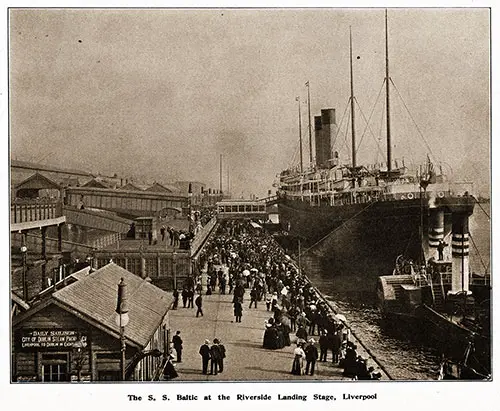
The SS Baltic (1904) at the Riverside Landing State, Liverpool. Steamers of the White Star Line, 1909. From the Chris Crofts Collection. GGA Image ID # 211087e98a
Liverpool's famous docks lay on our left by this time, mighty quays all these, with their heavy stone walls rising to support the long buildings, and often ending in a wee lighthouse. On the right, New Brighton climbed its hill, the houses, with their endless rows of roofs, seeming unbelievably clean to American comers.
The tower, one saw, rose from an ornate three-story red-brick structure that stood, a thing of beauty, amid trees. Flags flew from its lower pavilion, the top seemed to mock the heavy clouds now over all.
There was a theater and a dance-hall in the tower, some one told us, the fee was but six cents to the top. Along its foot we could make out the promenade, leading to the tip of the cape, where an old fort, built in a feudal style, still stood.
A ferry-boat crossed the Mersey here; ahead, in the river, four funnels in line announced the Lusitania at anchor. Liverpool's streets, sloping in curves landward, caught the notice when one wasn't watching the medley of boats lying here. Where, on the left, the great docks continued the stacks of still other vessels rose over the sheds.
These wharf houses were built stanchly on the stone walls of the piers, and familiar names, Cunard and so on, told the owners. High above the rest a tobacco warehouse rose here, a monster structure of a very dark brick; behind it stood a chimney as to some pottery, but serving another end.
Factory buildings came to hide whatever else of shore the docks did not conceal now, while out in the river another Isle of Man boat passed, laden with the pleasure-seekers thronging the place. The fare for the four-hour journey is but $1.50 around.
Liverpool's heart lay just off from the steamer. On our left the Liver (pronounced Ly-ver) Office Building arose, a handsome gray structure boasting the largest clock in the world for its tower aft from it.
New Brighton's fine sandy beach lay now, ranging back to the seawall, and a street hung, in its turn, with flags. Above this avenue, lawns, rich in shrubbery, sloped to the top of the palisade, where other splendid homes were built.
Aboard-ship, folk kept turning right and left now, to see all. On the Liverpool shore giant grain elevators towered, these buildings likewise of the dark brick. Between them, now and then, one caught sight of the street-cars, rounded, English fashion, at each end.
Just past the Liver Building stood the smaller home of the Dock Board, domed like St. Paul's in miniature. A sailor recounted how our ship might go from here on to Manchester, through the Canal; when another liner, the Carmania, a Cunard, diverted attention from his tale.
Near her a boat of the Clyde line was anchored; beyond lay a White Star liner. Now and then, rather seldom, one heard a boat-whistle. Americans missed the tugs and the railway-car ferries that one saw in the New York Harbor. Instead, a queer ferry-boat passed us, laden with freight, while we turned in the near-by slip.
Every incident now excited interest. Watches of the passengers still showed 12:42; on the Liver clock it was precisely noon. In Montreal, whence we'd come, a traveler showed us, it was 8:24 a.m. Some tourists were consulting Baedecker as to this harbor; others took occasion to jot into their diaries the item of it's being twelve to the second, on the world's greatest clock, when their vessel came to its journey's end.
Gulls came circling 'round the ship as she settled. Things on shore were not half so lively by far as they would be at a steamer's landing-time in New York.
Just off the stately white towers of the Liver we came to rest, finally. Long wooden docks were stretched at this place, edged in their turn by an ornate wooden shed, the roof of this painted a splendid black, rounded out and over to form an arcade, which wore, on its outer side, signs innumerable, done in distinctive English shades of all colors.
Here the refreshment and luggage rooms of the Riverside Railway Station were located.
The cleanliness of it al! won its praises from the strangers; so, too, did the order with which the crowds on the wharf had been held back to give room for the newcomers to reach customs at least.
Out over the arcade, from the top of its roof, a passage of iron had been built, and from this another gangway was shifted, allowing of passing from ship's deck to stairs and then shore.
Landing here, in fact, was easier than we'd found it anywhere else at the great ports; in fact, both in this and in arrangement for customs and railway, Liverpool, as a port, can teach many harbors a lesson indeed.
Inspection of Emigrants at the Port of Liverpool (1911)
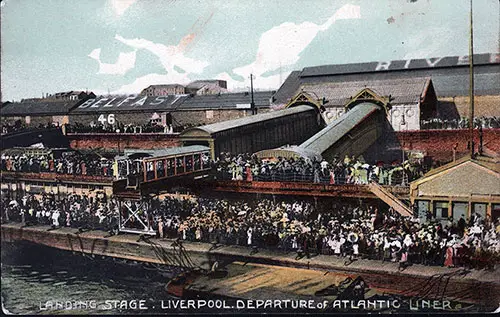
Departure of Atlantic Liner from the Landing Stage at Liverpool, ca 1900. GGA Image ID # 2112271d18
Liverpool is one of the four principal ports of Europe for the embarkation of emigrants, the others being Naples, Bremen, and Hamburg. Emigrants from all parts of northern and eastern Europe pass through the port.
The majority of the people from the Continent land at Hull or Grimsby, where they are taken in charge by representatives of the Liverpool lines and directed to their port of embarkation.
Several agents of the commission employed in the investigation of steerage conditions on trans-Atlantic ships passed through the port of Liverpool in the guise of emigrants. One of these agents describes his experiences there as follows:
On my arrival at Liverpool we were separated into groups once more. Those destined for the White Star Line and the Dominion Line were met by the agents of those companies; we were met by an agent of the Cunard Line.
Large busses with a seating capacity ranging from 6 to 25 awaited us right at the depot. Our hand baggage was put on top and off we went to the hotel. On our way we were divided again as to nationality, for the companies named try as far as possible to keep each nationality under one roof, or at least in one part of the hotel, thus avoiding unnecessary difficulties.
Here my booted Polish friends and their crying children left me for a time to meet me again on board the [Name of Ship Redacted]. I was sent to the Scandinavian Hotel because they took me for a Scandinavian.
The Cunard Hotel system is a village by itself in the center of Liverpool, and consists of several buildings, holding over 2,000 guests if need be. In those hotels second as well as third class passengers may remain until their steamer departs, entirely free of charge.
At the Hotel Cunard, where we stayed, we were welcomed by a matron and a hotel keeper in the uniform of the Cunard Steamship Company. We were asked most kindly to eat something before we retired. I said I did not care for anything, but they insisted that I should eat something or at least drink a glass of milk.
Then my room was shown to me. It held 10 beds and was well ventilated and provided with steam heat and electric lights. Both beds and floor were clean. I did not see any room in this hotel with more than 15 beds in it. Women are strictly separated from men in the sleeping rooms.
There are two dining rooms, one with a seating capacity of about 500, one with 200. The meals are wholesome. A printed menu was found in several conspicuous places. The Hebrews who stay in a separate hotel get kosher cooked meals.
The toilet and bathrooms were strictly sanitary and every part of them is marble and tile lined. The water-closets have running water. The hotel provided towels and soap. Mostly all the hotel employees were Britonized foreigners, so as to be able to understand the foreign-speaking guests. In our Scandinavian hotel for instance nearly all the employees were Swedes.
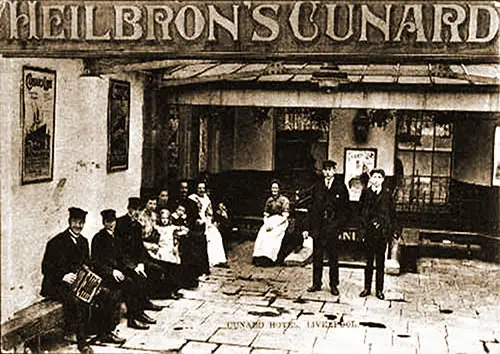
Max and Nellie Heilbron Were Owners of a Boarding House for Jewish Immigrants in Liverpool. The Image Above Dates From ca. 1917. Notice Is Hereby Given That the Partnership Heretofore Subsisting Between William Mosca Heilbron, George Heilbron, and Max Heilbron, Carrying On Business in Co-partnership Together at 1, 2, and 3, Great George Square, in the City of Liverpool, as Emigration Agents, Boarding-House Keepers, and Cigar Merchants, Under the Style of "a. Heilbron & Sons Has Been Dissolved by Mutual Consent as and From the 31st Day of December 1916, as From Which Date the Said George Heilbron and Max Heilbron and George Heilbron the Younger Have Carried on the Said Business, and They Will in Future Carry On the Business at 1, 2, and 3, Great George Square Aforesaid, Under the Style of "Heilbrons' Cunard Hotel."—Dated This Fourteenth Day of March 1917. William Rudd, Solicitor for All the Persons Mentioned Above, 10 Dale Street, Liverpool. (The London Gazette, 30 March 1917:3142) GGA Image ID # 2110df6eee
The hotel or emigrant boarding-house system above described is similar to those maintained by the other steamship lines carrying passengers from Liverpool.
On the arrival of emigrants at the steamship boarding houses they are examined by resident physicians of the steamship companies who visit the houses daily. In cases or suspected cases of infectious or contagious disease the emigrants are either rejected or held for further observation.
While the majority of rejections at Liverpool are made at the boarding houses, a considerable number are turned back at the steamer on the day of sailing. Emigrants are required to board the ship several hours before sailing, and there the final examination is made.
At this time emigrants are examined by one of the resident physicians of the steamship company, by the ship's doctor, and finally by a medical officer representing the British Board of Trade.
Under the British law one or more board of trade physicians are stationed at every port from which emigrants sail, and at the time of the committee's visit the services of four such medical officers were required in connection with the embarkation of emigrants at Liverpool.
When the examination is concluded a representative of the American consulate stamps with the consular seal the inspection cards of those passed.
As previously explained, the British Board of Trade doctors do not inspect emigrants for defects contemplated by the United States immigration law, and do not regard trachoma as a dangerous disease within the meaning of the British merchant shipping act.
Consequently steamship companies are forced to exercise every precaution to prevent the embarkation of persons likely to be rejected at United States ports. As usual, particular attention is paid to trachoma, and eye specialists are employed by the various lines to examine for this disease.
The various steamship companies at Liverpool endeavor to have their agents on the continent require a medical examination of intended emigrants in connection with the sale of tickets, and it was stated that some of the companies allow a fixed sum to cover the cost of such examination. Cabin passengers are not medically examined at Liverpool.
When cholera, plague, or other infectious or contagious diseases prevail in continental countries from which emigrants come such emigrants are detained at Liverpool for at least five days, and are examined daily by the steamship company's resident physician, who, after the completion of the observation, certifies to the American consul that he has made a daily inspection of the detained persons, that they are free from disease, and that they will sail on the ship specified.
Until this certificate is presented the consular bill of health is not issued. On the arrival of passengers from infected districts arrangements are made for the disinfection of their effects under the supervision of the American consulate.
This baggage is disinfected in accordance with the United States quarantine laws and regulations. A representative of the American consulate is always present while the disinfecting process is in progress and does not leave the premises until it is completed.
The committee was informed that the various steamship companies are always ready to carry out the requirements and suggestions of the consulate.
Hon. John L. Griffiths, American consul at Liverpool, at the time of the Commission's inspection, made the following statement relative to the situation at that port:
I have given a great deal of attention to the matter of the examination of third-class passengers sailing from this port to America and think that the examinations by the medical representatives of the Government and by the ships' surgeons are In the main satisfactory.
I have had recently an illustration at this consulate of the rigid character of these medical examinations.
An Armenian girl has been detained in Liverpool for over six months on account of trachoma, and has been pronounced cured by the physician attending her, and after such pronouncement has been twice rejected, the first time by the White Star Line, and the second time by the Cunard Company.
The fact that the steamship companies are required to bring back all rejected passengers and are penalized for taking them over to America Is of course, as you recognize, a most efficient safeguard.
I have talked frequently with the medical officers who conduct the examinations for the Government and for the steamship companies, and have been impressed with their sincere desire to do everything they possibly can to prevent the sailing of any persons who are tainted with a contagious or infectious disease.
Each third-class passenger is required to submit to at least three medical examinations before being finally accepted or rejected. I required an affidavit from the ship's doctor as to all rejected passengers and the cause of rejection, so that evidence may be preserved of these facts.
There is a representative from the consulate present at the final examination of third-class passengers sailing from Liverpool to American ports, and while he is not a medical expert and does not in any way control the medical examination, he does not stamp the " Inspection card" until after the passenger has been medically examined and approved.
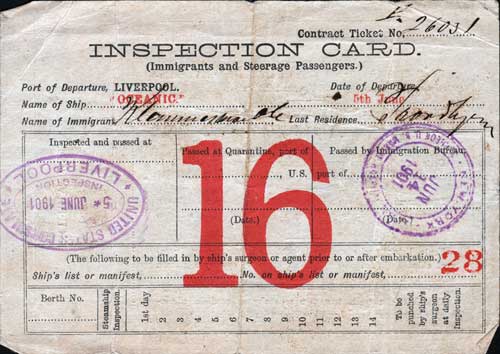
Example of an Inspection Card for Immigrants and Steerage Passengers, Stamped in Liverpool on 5 June 1901 as Inspected and Passed for a Norwegian Immigrant from Trondjem traveling on the White Star Line Steamship RMS Oceanic. GGA Image ID # 21125b2ee9
In addition to this the vice-consul or myself is present from time to time at these examinations. During the three years and more that I have been at the Liverpool consulate there has been no complaint as to ill-treatment of any sort on the part of third-class passengers, or of inadequate accommodations, or inefficient or unpalatable food at the boarding houses in Liverpool which are maintained by the steamship companies.
It is the practice of steamship companies at Liverpool to detain in that city all rejected steerage passengers whose physical disabilities, in the opinion of the company s physician, would be likely to yield to medical treatment within a reasonable time.
But this is only done when the company is assured by reliable persons or societies that the emigrant will be produced when demanded by the steamship company or-the inspector appointed under the British aliens act.
This act permits the transmigration through England of diseased or otherwise undesirable aliens who would not be permitted to remain in that country, and emigrants other than British finally rejected at British ports are deported to the country whence they came.
The British inspector is advised when emigrants are detained for treatment, as above explained, and is also informed as to the final disposition of case. The cost of the detention of diseased emigrants held for treatment is defrayed in various ways. In the case of Hebrews it is sometimes borne by the Jewish board of guardians, and sometimes by other charitable organizations, and in some cases the steamship companies meet the expense.
The Port of Liverpool - Study of European Ports (1909)
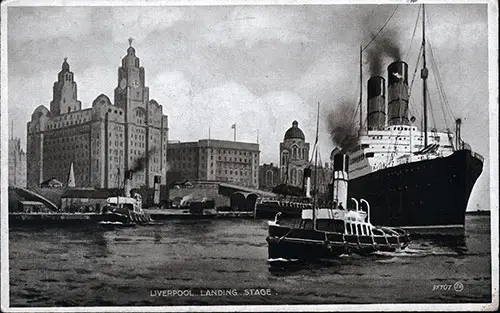
Outgoing Steamship from Liverpool with the Landing Stage Viewable in the Background, ca 1910. GGA Image ID # 2112c7d20a
When one crosses the Atlantic and arrives at the "Princes Landing Stage" at Liverpool, he at once realizes that he has reached one of the world's greatest ports.
Up and down the River Mersey as far as they eye can reach is one unbroken system of quays, docs and basins, carefully planned, well constructed, and equipped with the latest and best mechanical appliances.
From the opposite side of the ship can be seen another portion of this great dock system on the Birkenhead side of the River Mersey. And from the ship there also looms up what is locally known as the "White Palace", the office building and headquarters of the "Mersey Docks and Harbor Board", the Parliamentary Trust witch so ably manages this great Port and Trust.
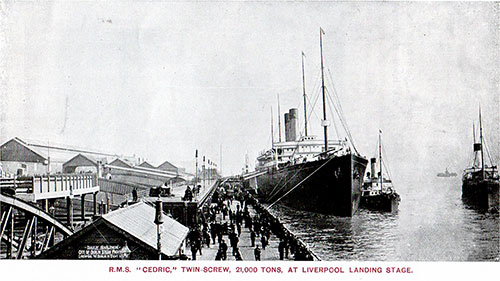
The RMS Cedric, Twin-Screw, 21,000 Tons, at the Liverpool Landing Stage. GGA Image ID # 144ea43f94
The "Princess Landing Stage" is so unusual to Americans that a brief description of its construction and uses seems important. At Liverpool, there is a range in extreme spring tides in the Mersey River of about 33 feet, and because of this great variation, it became necessary to construct some device for loading and unloading passengers and freight at varying tide levels.
The Landing Stage constructed for this purpose is 2,478 feet long by 80 feet wide, and is connected with the shore by eight bridges with swivel joints at each end and heavy mooring chains fastened near the base of the quay.
This large floating structure is supported by about 200 iron pontoons, each about 80 feet long, 10 feet wide and 6 feet deep. The deck of the Landing Stage is from six to eight feet above the water level, and lowering the movable gangways are used to reach the decks of the various sized vessels by easy inclines from the small ferry boats plying up and down and across the Mersey, to the largest ocean liners arriving and departing from Liverpool.
One of the bridges connecting the Landing Stage with the shore is 550 feet in length and 35 feet in width. It is used for highway purposes as well as for pedestrians, and is so constructed that at extreme low water the grade is 1 in 20; and at other stages of the river, less inclined or wholly level.
The northerly end of "The Princess Landing Stage" is used annually by about 6,000 ocean-going and coastwise vessels. These arrive at and depart from the port at any stage of the tide.
The central portion opposite the floating bridge is used for goods traffic across the Mersey River, and the southerly portion, about 800 feet in length, is appropriated for passenger ferry service, and is used by over twenty-eight million people each year. Mechanical conveyors are provided and used to handle luggage between steamers, railway trains, and other conveyances.
"The Princess Jetty", a fixed pile structure about 350 feet long has been constructed at the northerly end of the Princess Landing Stage for landing cattle and goods at all stages of the tide. Adjoining this is a commodious wharf with pens for cattle.
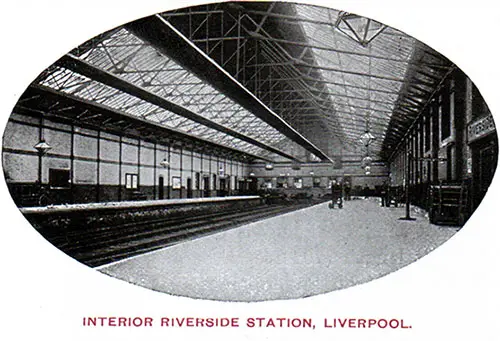
Interior View of the Riverside Station at the Port of Liverpool circa 1907. GGA Image ID # 1445f4ba32
On the shore opposite the Landing Stage is the Riverside Railway Station, a commodious and convenient structure for the arrival and departure of London passengers. Special four-hour trains are run between Liverpool and London connecting with inbound and outbound ocean-going steamers.
At present, the docks and basins consist of 427 acres of water area and 26 miles of lineal quayage on the Liverpool side of the Mersey River, and 165 acres of water area and 9 miles of lineal quayage on the Birkenhead side, making a total water area of 592 acres, and a total lineal quayage of 36 miles.
The area of the Dock Estate consists of 1,171 acres on the Liverpool side, and 506 on the Birkenhead side, or a total of 1,677 acres. On the Liverpool side the docs extend from the Hornby Dock on the north to the Herculaneum Dock on the south, a distance of over seven miles, with not a foot of property between these limits the Mersey Dock Estate owns large areas of foreshore property for future extensions of this great system.
The total cost of the great Liverpool Dock System has been over $150,000,000 and the yearly maintenance cost is between eight and nine million dollars.
The board has power to issue bonds from time to time, the amount authorized to date being $154,770,282. Bonds have been issued at rates of from 4 1/8, to as low as 2 1/2 per cent, and money borrowed to the extent of $122,483,552, leaving a balance of borrowing power on July 1, 1909 of $32,286,754.
The Board's revenue which amounts to about $10,000,000 annually is derived chiefly from rates received on vessels, dues on goods, and warehouse charges.
As there are no dividends to be paid, the income is used wholly for the maintenance of the high standard of the system and for future extensions; and when this becomes more than sufficient for such purposes, the rates are lowered accordingly.
The growth of the Port of Liverpool is well illustrated by the following decade statistics since 1858:
The docks on the Liverpool side are constructed both parallel with and at right angles to the Mersey. They extend back from the shore line for distances varying from 800 to over 2,000 feet, ending near a marginal elevated railway, from the trains of which can be obtained a splendid general view of the ceaseless activity of this mammoth undertaking. Underneath the elevated railway there is a dock railway on the quay level.
In the entire system there are sixty-three wet docks, nineteen dry docks, and four basins. All of the docks are enclosed by heavily constructed locks and gates to maintain a constant depth of water, while the basins are unprotected by gates, and the water in them rises and falls with the tides.
Of the docs, twelve on the Liverpool, and two on the Birkenhead side of the Mersey have water areas equal to or greater than ten acres, the largest being the Canada Dock with a water area of twenty-four acres.
Thirteen of the docks have a lineal quayage of over 3,000 feet, the largest again being the Canada Dock with over 4,000 feet. There are also eighteen dry docks at Liverpool and three at Birkenhead, with a total floor length of 12,575 feet.
The Liverpool docks and quays are equipped with every conceivable mechanical appliance for handling business expeditiously and economically.
On the Liverpool side of the Mersey, there are two hundred and sixteen hydraulic cranes and jiggers lifting from one to one hundred tons each; sixteen steam cranes, twelve of which are movable roof cranes lifting from one to twenty-five tons each.
On the Birkenhead side, there are seventeen hydraulic, steam, and hand-power cranes, lifting from one to twenty-seven tons each.
The Langton Graving Dock is equipped with a movable hydraulic crane capable of lifting thirty tons in any of the four chambers of the dock. In addition there are four floating barge cranes -- The "Hercules", The "Samson", The "Atlas", and the "Titan", capable of lifting respectively, 50, 30, 30 and 25 tons each. These cranes are continually in demand in the heavy dock and river work in and around Liverpool.
All of the marine work of the Port of Liverpool is carried on by the Mersey Docks and Harbor Board, the following equipment being utilized for the purpose; five sand pump dredges, fourteen ladder or grab dredges, sixteen steam hopper barges, two steam tugs, two survey steamers, two steam launches, thirteen lightships and watch vessels, twenty-six barges, four steam pilot vessels, making eighty-four vessels in all.
A twin-screw self-propelling sand pump hopper dredger, "The Leviathan", (the largest in the world) has recently been built for the Board. This dredger cost about $750,000 and is capable of dredging 10,000 tons of sand every fifty minutes in a maximum depth of seventy feet of water. The dimensions of the dredger are, -- length over all 479 feet, breadth 69 feet, draught 23 feet, and speed, when loaded, 10 knots per hour.
The Mersey Board has charge of the pilotage, lighting, and buoying of the channel. For this purpose there are nine lighthouses, built between 1830 and 1908, equipped with the most up-to-date electric, or gas dipodic lights, both fixed and flashing, which can be seen for distances varying from three to twenty-four nautical miles.
There are also five light-ships equipped with lights visible for ten nautical miles, and fog signals. Gas lights on buoys are arranged at seven different locations in the various channels with lights visible for three or four miles. Fire, telegraph, telephone, and semaphone stations are also maintained.
The Mersey Docks and Harbor Board does an enormous store housing business, special warehouses being provided for the principal classes of goods as follows:
Total 9,901 Lin. Ft.
* The whole of the Morpeth Warehouses and Blocks B & C of the Wallasey Warehouses now form part of the Birkenhead Foreign Animals Wharf and are not available for general traffic.
At the Wellington, Canada, Bramley-Moore, and Herculaneum Docs on the Lancashire side, and the east and west floats on the Birkenhead side, every facility, even to floating elevators, has been provided for adequately handling the coal trade.
Two cases taken from the Liverpool handbook well illustrate the facilities for the rapid handling of cargoes and clearing the quays at the Liverpool Docks. "The Lake Champlain arrived in Liverpool on a certain Sunday, and in forty-eight hours had discharged 12,000 tons measurement of cargo, and sailed again the following Wednesday morning with 2,000 tons of coal and cargo, and a large contingent of troops"
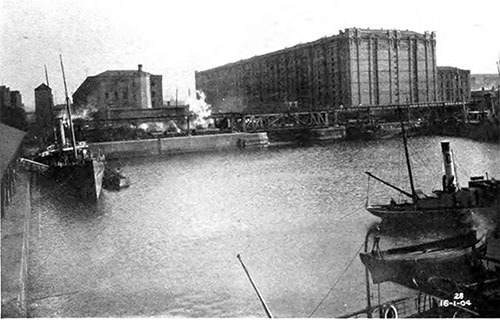
New Stanley Dock Tobacco Warehouse. This warehouse contains 12 floors, each having an area of three acres. The storage capacity is about 55,000 casks of tobacco. GGA Image ID # 1450cdc01f
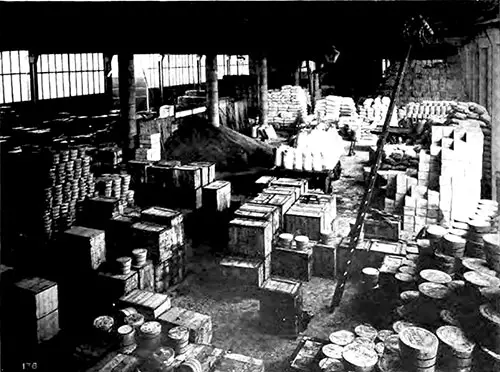
Ground Floor of a Double Story Shed Showing Inward Cargo. GGA Image ID # 14510143d2
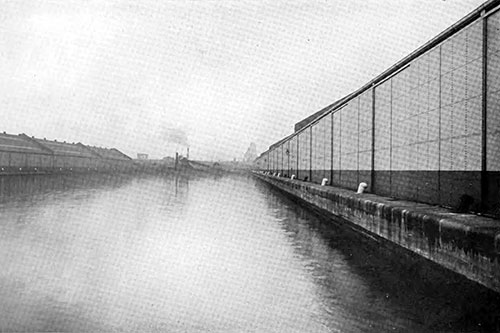
View Showing One of the New Docks with Modern Fireproof Sheds on Edge of Quays. GGA Image ID # 145117d078
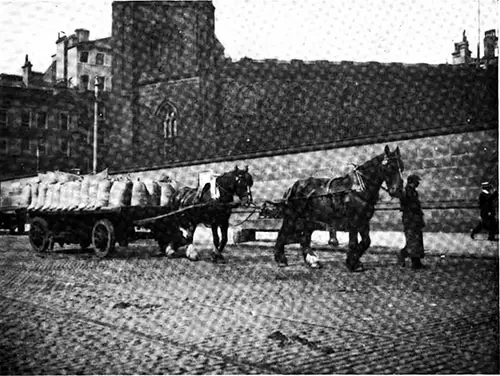
Two-Horse Tandem Hitch Transporting Goods from Docks to Warehouses. These horses are said to haul loads of 12 tons per horse over the Liverpool pavements. GGA Image ID # 14512ad93c
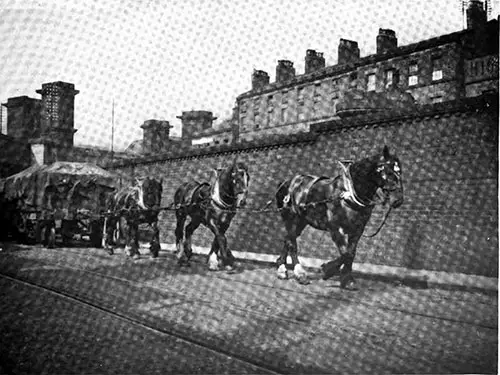
Three-Horse Tandem Hitch Hauling a Loaded Freight Car Around the Liverpool Docks. GGA Image ID # 145137b9a8
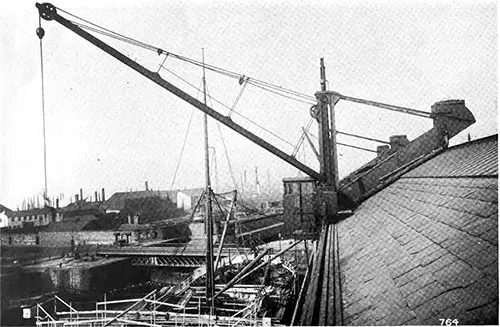
Traveling Roof Crane with a Maximum Capacity of 15 Tons. GGA Image ID # 1451467cda
"The SS Irada from Galveston, with 30,000 bales of cotton, 640 tons of wheat, and 2,800 bags of flour, commenced to discharge at 1 PM on the 5th of November, 1900, and finished at 10 PM on the 9th of that month, the working time being sixty hours.
The steamer took in about 2,500 tons of bunker coal, and sailed again at noon on the 10th of November, 1900. Nearly the whole of the cotton was weighed as landed, and removed by the consignees within three days."
The new Stanley Dock Warehouse for the storage of tobacco is one of the largest storehouses in the world. It is 723 feet long, 165 feet wide and 13 stories (about 125 feet) high.
It is of fireproof construction being built of brick and steel with concrete floors. Over 27,000,000 bricks and 6,000 tons of iron were used in its construction. It has a capacity of over 60,000 casks of tobacco in single tier without piling.
The Mersey Board also maintains a Lairage (foreign animals wharf) at Birkenhead, with a ground area of over 900,000 square feet and a capacity of 6,172 oxen and 16,000 sheep.
Connected with this wharf are slaughter-house accommodations for over 6,000 head of cattle and sheep, and chilling rooms for handling about 3,000 carcasses per day.
While the Mersey Dock Estate possesses over eighty miles of railway track around the great docks, it is interesting to note that over 90 percent of the traffic of the port is handled to and from the ships and warehouses in horse-drawn drays or "lurries".
From early morning till late at night there is one continuous procession of these four-wheeled, heavily laden drays travelling along the border highway of the great estate.
The platform bodies project over the wheels, giving a large loading surface. The horses are powerful beasts, and are usually hitched up in tandem style with from one to three horses to each dray. It is said that some of these powerful Clyde horses draw loads of ten tons each, over the Liverpool pavements.
This requires, especially on the heavy traffic streets, surfaces which are hard and durable with low tractive resistance and good foothold for the horses. Most of the pavements on such streets are of granite or the famous Liverpool stone sets (small cubes of granite or whinstone from three to six inches square on each surface).
After studying the great docks of Liverpool, which, as a system, stand without a rival, and noting how skillfully and smoothly they are run, one naturally wants to learn something about the Trust which so successfully manages them for the benefit of the public.
Prior to 1857, the Liverpool Docks were managed by the Liverpool Corporation, and the docks on the Birkenhead side by a private company later purchased by the City of Liverpool.
By an act of Parliament passed in 1857, the ownership and management of all the docks and works connected therewith on both sides of the Mersey River became vested in a public trust known as "The Mersey Docks and Harbour Board."
This Board consists of twenty-eight members, twenty-four of whom are elected by the Dock Ratepayers (persons paying rates and dues on ships and goods), and the remaining four are appointed by the Mersey Conservancy Commissioners consisting of the First Lord of the Admiralty, the Chancellor of the Duchy of Lancaster, and the President of the Board of Trade.
The members of the Board are men of the highest character and attainments, and serve without compensation. The Board with its large staff of officials and employees is now housed in a magnificent new office building located near the Princess Landing stage.
The central portion of the building is octagonal in shape, and on the panels between the first and second floors is the following inscription which those who have crossed the Atlantic for the first time can fully appreciate.
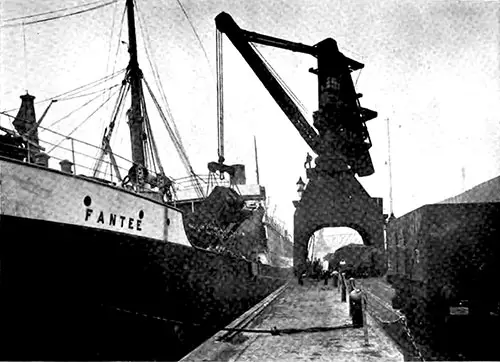
Powerful Hoisting Crane Putting Coal in Steamship. GGA Image ID # 1451958426
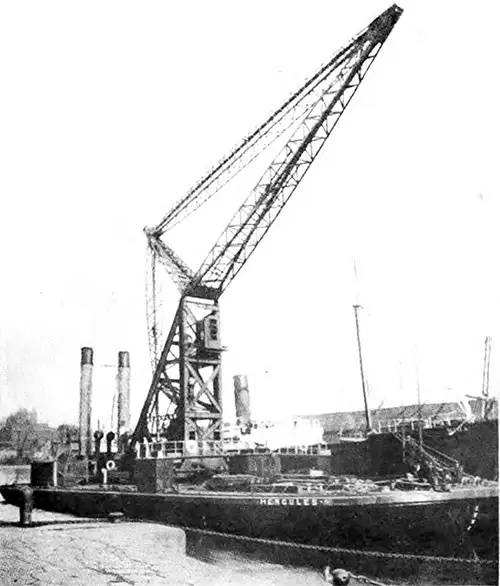
Floating Barge Crane "Hercules" with a Maximum Lifting Capacity of 50 Tons. GGA Image ID # 1451f604f1
The London & North Western Railroad of England (1908)
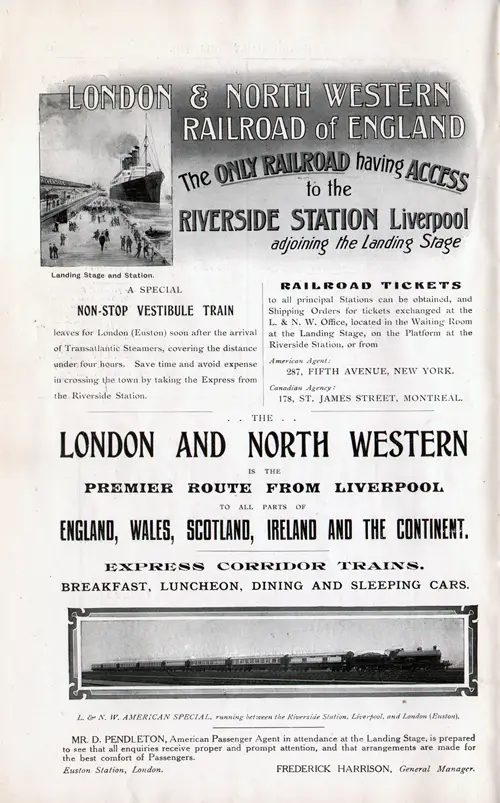
Photo Insert (Top Left): Landing Stage and Station. Period Advertisement from 1908 from the London & North Western Railroad of England that touted their exclusive access to the Riverside Station in Liverpool located adjacent to the Liverpool Landing Stage. Cunard Daily Bulletin, Ivernia Edition, 22 July 1908. GGA Image ID # 2113030ebe
The London & North Western Railroad of England is the Only Railroad having Access To The Riverside Station Liverpool Adjoining the Landing Stage
A SPECIAL NON-STOP VESTIBULE TRAIN leaves for London (Euston) soon after the arrival of Transatlantic Steamers, covering the distance under four hours. Save time and avoid expense in crossing the town by taking the Express from the. Riverside Station.
RAILROAD TICKETS to all principal Stations can be obtained, and Shipping Orders for tickets exchanged at the L. & N. W. Office, located in the Waiting Room at the Landing Stage, on the Platform at the Riverside Station, or from
American Agent:
287, FIFTH AVENUE, NEW YORK.
Canadian Agency:
178, ST. JAMES STREET, MONTREAL.
-:-:- -:-:- -:-:- -:-:- -:-:- -:-:- -:-:- -:-:- -:-:-
LONDON AND NORTH WESTERN
IS THE
PREMIER ROUTE FROM LIVERPOOL
TO ALL PORTS OF
ENGLAND, WALES, SCOTLAND, IRELAND AND THE CONTINENT.
EXPRESS CORRIDOR TRAINS,
BREAKFAST, LUNCHEON, DINING AND SLEEPING CARS.
Photo Insert (Bottom Center): L. & N.W. AMERICAN SPECIAL, running between the Riverside Station, Liverpool, and London (Euston).
MR. D. PENDLETON, American Passenger Agent in attendance at the Landing Stage, is prepared to see that all enquiries receive proper and prompt attention, and that arrangements are made for the best comfort of Passengers.
Elision Station, London.
FREDERICK HARRISON, General Manager.
Album of Photo-Lithographic Views of Liverpool and New Brighton (1898)
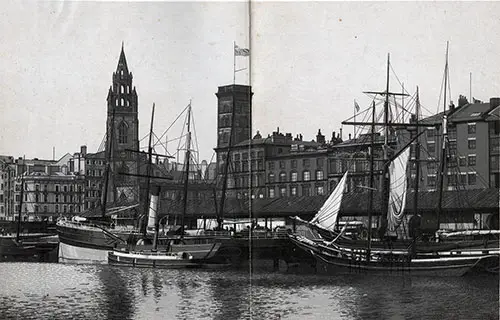
St. George's Dock and St. Nicholas Church. Two ships are docked - one a clipper or sailing vessel and the other, a steamship equiped with sails being guided by a tug shown in the foreground. GGA Image ID # 14523f267d
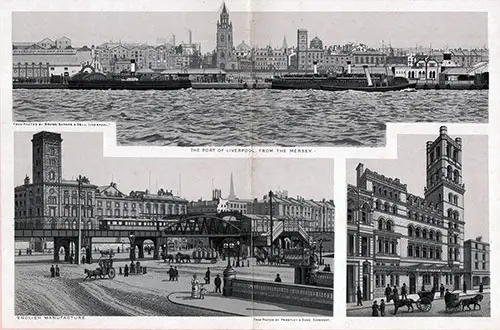
Clockwise: The Port of Liverpool from the Mersey with several steamships visable in the foreground; A view of the Mersey Tunnel Station with horse-drawn carts visable in the foreground; The Overhead Railway showing an entrance and surrounding street life. GGA Image ID # 1452465176
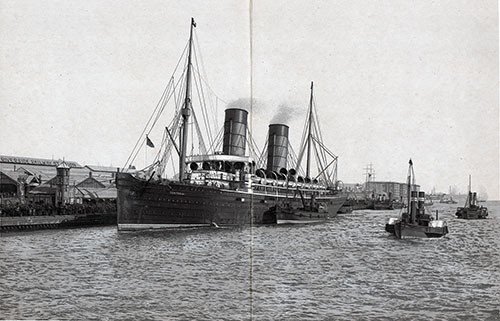
The Cunard Campania Mail Steamer at the Landing Stage. Note the tug boat that just guided her into the landing berth with two other tugs shown on the right that likely assisted in guiding the SS Campania into port. GGA Image ID # 14527cb6cb
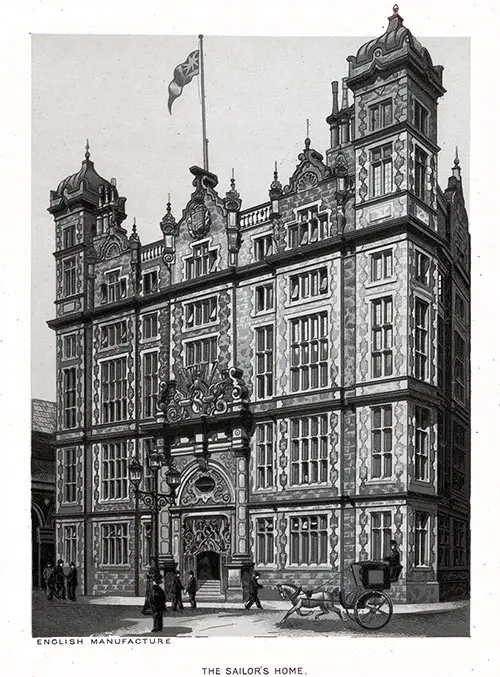
Liverpool Sailors' Home, open for business in Canning Place, Liverpool, England from December 1850 to July 1969, was designed to provide safe, inexpensive lodging for sailors, and to offer educational and recreational opportunities. Note the depection of street life in this illustration with horse-drawn carriage and men in business suits. GGA Image ID # 14528cd12d
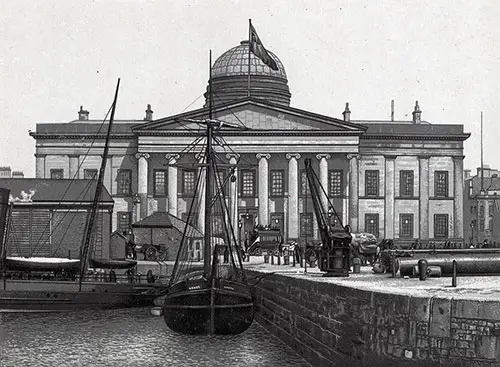
The Liverpool Custom House, built by John Foster on the site of Liverpool's Old Dock, was completed in 1839. Badly damaged during the Second World War, the building was demolished in 1948. GGA Image ID # 1452be2674
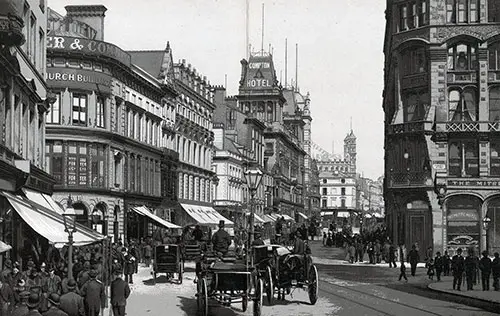
Church Street. Superb photograph from the late 1800s showing stret life, businesses, pedestrians and horse-drawn carriages. GGA Image ID # 1452eaab51
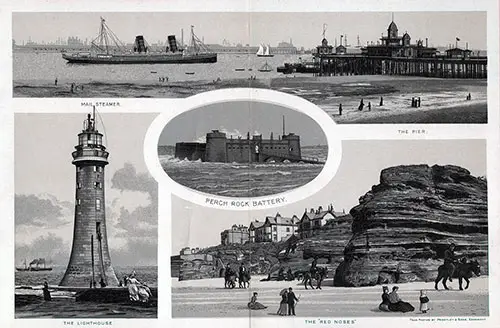
Clockwise: Mail Steamer; The Pier; The Red Noses; The Lighthouse; Perch Rock Battery. GGA Image ID # 1452f25e25
Liverpool, England - Background to the New Dock, 1895-1913
During the latter half of the 19th century Liverpool became Britain’s No 1 port for passengers wishing to travel to America, and earned for itself the soubriquet The Gateway to the West’. The shipping and commerce of the Mersey were exceeded only by those of the Thames with its Port of London and also Tilbury.
Liverpool’s premier position was first threatened in the 1890s after the London & South Western Railway purchased Southampton Docks in 1892 and initiated substantial improvements. Southampton Water is fortunate in enjoying a protracted high water due to the tidal flows from the Solent and also from Spithead. The new owners soon realized that the question of a quick turn-round for ships was of paramount importance. Ships are very expensive and individual investments, and earn no dividends for their owners when they are idle and not at sea.
Because of the Mersey’s remarkably high tides, often as much as 32 feet, the docks had to he enclosed by a wall some 10 feet thick and reaching 12 feet above the maximum high-water mark. Access to the docks was gained by three main entrances located at Canada, Sandon and Brunswick docks and connected to the river by half-tide basins. The need to use these sea locks caused delays to liners, which frequently spent hours at anchor in the river waiting for the tide in order to enter dock and, when tides were exceptionally low, even to reach the Landing Stage to discharge their passengers.
The Competition for Passengers
Five famous companies competed for the passenger and mail traffic to North America: Allan and Dominion running to Canada, and Cunard, White Star and the American-owned Inman & International running to the United States.
The Americans in particular were dissatisfied with the delays experienced at Liverpool and were easily enticed to Southampton by the advantages offered there; care had been taken to ensure that the new Ocean docks on the Solent were open basins whose quays could he reached by the largest liners at all states of the tide, and where they were able to conduct the whole business of the turn-round between voyages without further movement.
Ownership and Management of the Docks
Liverpool’s docks were owned and managed by the Mersey Docks & Harbour Board, and the loss of the American liners concentrated the minds of the Board members to consider counter-measures. One proposal was to utilize a large area of land at the north end of the system and construct an estate that would provide direct access from the river at all states of the tide for even the largest ships. Some members of the Board who were mainly concerned with cargo traffic, including the Chairman, Alfred Holt, considered that the money could be better spent on improving existing facilities.
It was finally decided as a compromise to deepen the bed of the river at the Landing Stage and to widen the entrance at Sandon from 80 feet to 100 feet. These were wise decisions as they would enable the new large vessels already planned by Cunard to reach the company’s berths at Huskisson Dock and the Board’s largest graving dock at Canada Dock. However, these improvements would do nothing to cut the waiting time caused by the Mersey tides.
White Star Line
In 1902 the White Star Line joined the powerful International Mercantile Marine, which was financed by American capital, and decided to build two of the world’s largest lines. To conform with American practice they would terminate their No 1 passenger and mail service from New York at Southampton. Once again the Dock Board saw passenger-shipping moving away from Liverpool, and the new dock proposal was re-examined. This time it was suggested that a three-branch estate should be constructed, including a dry dock that could accommodate ships up to 1,000 feet in length. Parliamentary powers were approved in 1906, but the idea was shelved when it was estimated that the cost of the work would he over £2 million.
The Cunard Line
In 1905 Cunard Line began to build its new super-liners, which were expected to be not only the fastest in the world, hut also the largest, with a length of 790 feet and a beam of 88 feet. The fear of losing these also to Southampton was allayed when Cunard declared its intention of continuing to use Liverpool as its terminal port.
As it was expected that the ships would spend only five days in port before sailing again, Cunard had no wish to arrange for the new ships to enter dock unless it was specially necessary. Instead it asked that a large buoy be moored in the river off Woodside, at which the liners could complete the turn-round.
This was provided, and additional measures included the removal of a further large quantity of rock and silt from the bed of the river at the Landing Stage, whose passenger facilities were further improved by the fitting of an upper deck.
The two superliners, named Lusitania and Mauretania, duly entered service and, although capable of their designed speed of 25 knots, it was usually found necessary to use a third ship in order to maintain a weekly transatlantic service. Either the much older Campania or the Lucania was used until a third super-liner could enter service.
In 1910 Cunard duly announced that it was ordering a third vessel to match the luxury of the first pair, but she would be considerably bigger to compete with the rapidly increasing size of Atlantic liners. It was expected that her tonnage would be 45,500 with a length of 901 feet and a beam of 97 feet - the thousand-foot liner had almost arrived.
Cunard was certainly not prepared to service so large a ship at the river buoy, and stated that unless a dock was forthcoming that could accommodate the new Aquitania, the service would have to move to Southampton.
At last the Dock Board decided on a positive course of action. A modern dock estate would be built, but there would certainly not be sufficient time to complete a three-branch project before the new ship came into service.
Consequently it was decided to build the new estate in accommodation in time. It would be something of a race between the new ship and the new dock - fortunately the dock won by some nine months.
The New Docks
The first stage, which was completed by April 1913, entailed the construction of a single basin 1,050 feet in length. Its 120-foot-wide entrance was connected by a direct channel to the Mersey and was consequently capable of being used at all stages of the tide.
The basin would have dual functions: when flooded, cargo could be handled using the latest quayside equipment and transport facilities, and when ‘dried out’ it would become the largest graving dock in the world. Originally it had been hoped that the whole estate would be finished by the summer of 1918.
King George V and Queen Mary duly opened the graving dock on 11 July 1913 and the occasion included one of the finest parades of shipping ever seen on the Mersey.
The Royal Party steamed through the lines of ships aboard the Dock Board’s tender Galatea. Unfortunately the Great War prevented any further construction work, and it was to be 14 years before the estate was completed.
Gleaming's and Anecdotal Stories about the Port of Liverpool
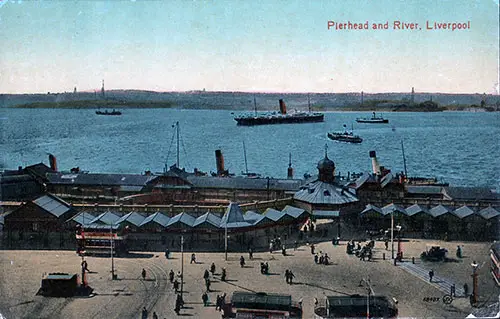
Steamship in the harbor of Liverpool on the Mersey River. Pierhead in the Foreground. GGA Image ID # 14532131bf
IT could be wished the ocean steamship companies had better and less profanity-provoking methods of landing passengers at Liverpool than are now the rule. In pleasant weather it is bad enough, but when it rains the situation is horrible.
And, too, baggage should not be given the preference over passengers, who have to wait on the same miserable, cabin-less tender for hours, moored to Princess Landing, while drones and human snails take off the cabin baggage. The system is something like an hundred years behind the age!
Sailing Schedules that Include the Port of Liverpool
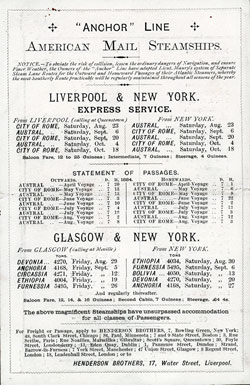
Anchor Steamship Line Sailing Schedule, 23 August 1884 to 18 October 1884
Steamers and Ocean Liners operated by Anchor Steamship Line, were scheduled for transatlantic voyages between 23 August 1884 to 18 October 1884.
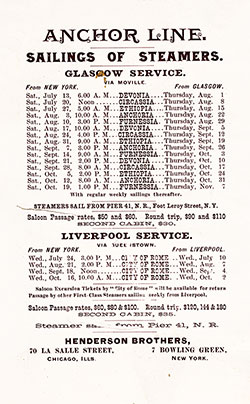
Anchor Steamship Line Sailing Schedule, 31 July 1889 to 7 November 1889
Steamers and Ocean Liners operated by Anchor Steamship Line, were scheduled for transatlantic voyages between 31 July 1889 to 7 November 1889.
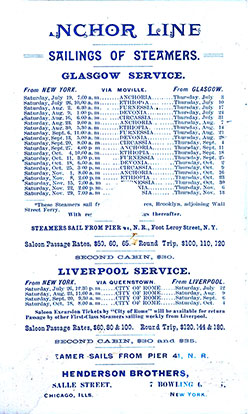
Anchor Steamship Line Sailing Schedule, 19 July 1890 to 29 November 1890
Steamers and Ocean Liners operated by Anchor Steamship Line, were scheduled for transatlantic voyages between 19 July 1890 to 29 November 1890.
Bibliography
"Liverpool Landing Stage Improvements," in Shipping: Marine Transportation, Construction, Equipment and Supplies, New York: Shipping Publishing Co, Volume 15, No. 3, February 10, 1922, p. 39.
Great Western Railway, Handbook for Travellers from Overseas, 1913.
Koch, Felix J., "Famous Ports as Laymen See Them," in The American Marine Engineer, Volume VII, Number 3, March 1912, Pages 7-8.
"The Port of Liverpool," (Inspection of Emigrants at the Port of Liverpool) in Report of the Immigration Commission, Emigration Conditions in Europe, Volume 4 (S. Doc. No. 748, 61st Cong., 3d Sess.) Government Printing Office, Washington,DC, 1911, Pages 85-88.
Frederick L. Ford "The Port of Liverpool," in "Part II. A Study of Some Representative European Ports in the Summer of 1909", in the Report of Connecticut Rivers and Harbors Commission to the General Assembly, Hartford: State of Connecticut, 1911, p.25-32
"The London & North Western Railroad of England," in the Cunard Daily Bulletin, RMS Ivernia, Wednesday, July 22, 1908, Page 14.
Album of Photo-Lithographic Views of Liverpool and New Brighton, Brown & Rawcliffe, Chromo Lithographers, Colour Printers Publishers & Co., 1898.
"Gleaming's and Anecdotal Stories about the Port of Liverpool" in Ocean: Magazine of Travel, Vol. III, No. 2, September 1889, Page 42.
